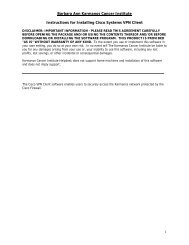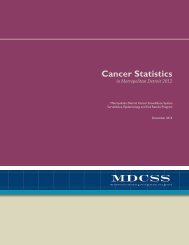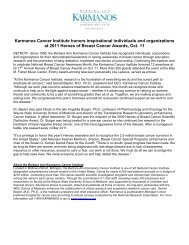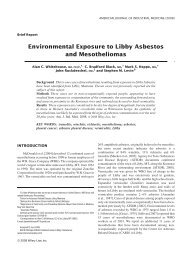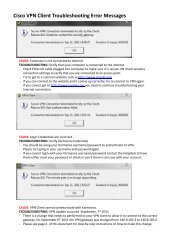Fall 2006 - Karmanos Cancer Institute
Fall 2006 - Karmanos Cancer Institute
Fall 2006 - Karmanos Cancer Institute
Create successful ePaper yourself
Turn your PDF publications into a flip-book with our unique Google optimized e-Paper software.
<strong>Karmanos</strong> Researchers Are Not Only Fighting <strong>Cancer</strong>,<br />
They’re Creating High-Tech Jobs In Detroit<br />
THE CENTER OF INNOVATION<br />
NEB DURIC, PH.D.<br />
Whether they’re conducting the earliest tests of<br />
new drugs or developing new technologies to detect<br />
breast cancer, researchers at the <strong>Karmanos</strong> <strong>Cancer</strong> <strong>Institute</strong> are<br />
receiving national recognition for their work – and multi-million<br />
dollar grants from the State of Michigan.<br />
Two <strong>Karmanos</strong> researchers recently received a total of $4.2<br />
million in grants from Michigan’s 21st Century Jobs Fund, a<br />
program designed to create high-tech jobs in the state.<br />
CREATING A NEW TECHNOLOGY<br />
Neb Duric, Ph.D., professor of radiation oncology at the <strong>Karmanos</strong><br />
<strong>Cancer</strong> <strong>Institute</strong>, along with Peter Littrup, M.D., Earle Holsapple<br />
and several other <strong>Karmanos</strong> colleagues, received a $1.6 million<br />
grant to support continued development of a new breast imaging<br />
technology called Computed Ultrasound Risk Evaluation (CURE).<br />
The technology promises to overcome the limitations of current<br />
breast imaging techniques and may soon help physicians detect<br />
breast cancer at its earliest stages.<br />
“Despite great progress in the detection, diagnosis and treatment<br />
of breast cancer in recent years, major limitations in breast imaging<br />
still remain,” Dr. Duric said. “Mammography is the traditional ‘gold<br />
standard’ for breast imaging, but it is often unable to discern benign<br />
masses from cancerous masses – leading to many unnecessary breast<br />
biopsies.” In women with dense breasts, traditional mammography<br />
makes it difficult to see certain masses. This can lead to missed<br />
opportunities to treat cancer in its earliest stages.<br />
The new technology should help. Unlike mammography, the<br />
CURE technology does not use harmful radiation and does not<br />
compress the breast. Initially, the grant funds will be used to create<br />
new research-related jobs at the <strong>Karmanos</strong> <strong>Cancer</strong> <strong>Institute</strong> –<br />
helping the CURE team to finalize development of the technology<br />
and bring it to market within the next few years.<br />
STUDYING<br />
NEW CANCER<br />
DRUGS<br />
Patricia LoRusso,<br />
D.O., director of<br />
the <strong>Karmanos</strong><br />
<strong>Cancer</strong> <strong>Institute</strong>’s<br />
Phase I Clinical<br />
Trials Program,<br />
received a $2.6<br />
million grant to<br />
expand the<br />
Program, currently<br />
the only Phase I<br />
cancer program in<br />
Michigan, and one of only 14 in the country.<br />
PATRICIA LORUSSO, D.O.<br />
A Phase I trial is the first test of a new drug – or a new combination<br />
of previously approved treatments – in humans. Phase I trials are<br />
designed to determine a drug’s appropriate maximum dosage<br />
(maximum tolerated dose) and to identify possible side effects.<br />
“We take drugs that have been identified in the lab as having<br />
promise – drugs that have also been identified as being safe – and<br />
we give them to patients,” said Dr. LoRusso. “It’s a vital part of<br />
developing new cancer therapies.”<br />
The funds will add nearly 25 employees to the Phase I Program,<br />
including physicians, nurses, research professionals, clinical care<br />
professionals and various support staff. Increasing the size of the<br />
<strong>Institute</strong>’s Phase I Program not only allows more patients to<br />
participate in cancer treatment research, but physicians will have<br />
the ability to test many more anti-cancer compounds currently in<br />
development. The grant will also allow the program to increase the<br />
complexity of the Phase I trials available to patients.




